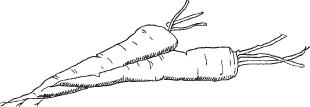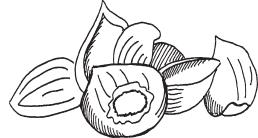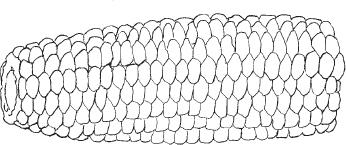Nourishing Traditions: The Cookbook That Challenges Politically Correct Nutrition and The... (106 page)
Authors: Sally Fallon,Pat Connolly,Phd. Mary G. Enig
Tags: #Non-Fiction, #Reference, #Science, #Health
The superb accomplishments of modern medicine in managing accidents, infections and surgery will be of little help curing any of these. Before the "diseases of civilization" medicine is almost as powerless as we are. Joseph D. Beasley, MD and Jerry R. Swift, MA
The Kellogg Report

CAULIFLOWER
Separate cauliflower into flowerets. Steam about 10 minutes or until just tender. Transfer to a heated bowl and toss with a generous pat of butter, pepper, sea salt and a few grindings of nutmeg.
Breaded Cauliflower
Serves 6
1 head cauliflower
6 tablespoons melted butter
2 cups whole grain bread crumbs
4 tablespoons Parmesan cheese, finely powdered
sea salt and pepper
Steam cauliflower flowerets until not quite tender. Drain, pat dry and toss well with melted butter. Mix bread crumbs with cheese and season to taste. Dip each floweret into bread crumb mixture. Place flat side down in a buttered, glass baking dish. Bake at 350 degrees for about 15 minutes or until golden brown.
Mark Twain once called the cauliflower a "cabbage with a college education." This does not speak very highly for college educations, as the cauliflower is lower in nutrients than its cousin broccoli. Nevertheless, cauliflower is a staple winter vegetable and not to be despised for its fiber and mineral content. It is also high in biotin, a B vitamin that plays an important role in the body's fat production. Studies in Norway indicate that the cauliflower may give better protection against cancer of the colon than its cousins broccoli and cabbage. The new purple varieties now seen in some markets actually contain more carotenoids than white cauliflower. You needn't be put off by the color, they taste fine. SWF
The cooked vegetables are better since raw vegetables are usually too bulky to allow very much mineral to be obtained from them. Some of the best of the cooked vegetables are cauliflower, brussels sprouts, asparagus tips and celery. Weston Price, DDS
Letter to His Nieces and Nephews
1934
CHARD
Chard is one of many nutritious greens available year round. It is more bitter than spinach but less expensive.
Remove stalks from leaves and tear into pieces. Wash well in filtered water but do not shake off water. Place in a covered, heavy pan over a medium flame. When chard begins to simmer, reduce heat and simmer until just wilted. Using a slotted spoon, transfer to a serving dish. Use the back of the spoon to squeeze out any excess liquid, and pour this off. Cut up coarsely, toss with butter and season to taste with sea salt and pepper.
Alternately, saute chopped red onion in a generous amount of butter. Chop chard coarsely, add to onions, cover and steam a minute or so until wilted.
Chard is a member of the beet family, selectively bred for its leaves rather than its root. Although chard is often referred to as Swiss chard, the champions of this versatile vegetable are the French who add it to soups, stuffings, pates and pancakes. Like all dark green leafy vegetables, chard is rich in iron, calcium, magnesium, vitamin C and carotenoids. Chard should always be eaten cooked as it contains oxalic acid that may irritate the mouth and intestinal tract. These are neutralized during cooking. Chard grown with high-nitrate commercial fertilizers may also be high in nitrates. Avoid buying chard that is not organically grown. SWF
CHESTNUTS
To cook chestnuts, saute frozen or freshly peeled chestnuts in a little butter. Season to taste with sea salt, pepper and a little freshly grated nutmeg. (To peel chestnuts, see sidebar.)
Chestnut Puree
Serves 6
6 ½ ounces (1 package) frozen chestnuts or 2 cups freshly peeled chestnuts
1 cup
beef stock
or
chicken stock½ cup
piima cream
or
creme fraichesea salt and pepper
Cook chestnuts, uncovered, in stock until tender. Remove with a slotted spoon to food processor and process along with enough stock to achieve desired consistency. Blend in cream and season to taste. Transfer to a heated serving dish and keep warm in oven.
Chestnut-Stuffed Zucchini
Serves 6
2 cups chestnut puree
6 medium zucchini
sea salt
Trim ends off the zucchini and plunge into boiling salted, filtered water. Cook about 8 minutes or until just tender. Remove to a colander and rinse with water. Cut the zucchini lengthwise and scoop out center, leaving about ¼ inch of outer flesh. Sprinkle insides with sea salt and place on paper towels, cut side down, for about 15 minutes to drain. Wipe insides with paper towel and fill with puree. Arrange in a buttered, glass baking dish and bake at 250 degrees for about ½ hour.
Highly prized in Europe, the chestnut is a vegetable almost completely absent from American tables. This may be because a blight destroyed America's vast chestnut forests in the early 1900's.
As the flesh is soft at maturity, chestnuts are consumed as vegetables. The chestnut has the lowest fat content of any edible nut and, conversely, a high carbohydrate content—hence the characteristic sweetness of the chestnut. They contain some protein and are rich in B vitamins, calcium, iron, phosphorus and potassium. Like the fruit of all trees whose roots extend far into the ground, chestnuts are a good source of trace minerals.
Chestnuts are in season in the fall. Select firm nuts with shiny skins.
To peel chestnuts, cut an X with a sharp knife on the flat side and roast or boil them for 10 to 15 minutes before removing the skin. Peeling chestnuts for purees, soups or stuffings is a chore; but fortunately peeled, frozen chestnuts are now available. Asian markets also carry peeled, dried chestnuts. These take all the work out of serving chestnuts and should set the stage for a comeback of this delicious vegetable. SWF

CORN
Shuck and wash corn. Place sidewise in a frying pan with about ½ inch filtered water. Cover and steam lightly for 5-10 minutes or until corn is just tender. Don't let corn get mushy—it should still have some crunch. Serve with butter,
herb butter
or
pesto
.An alternate method is to leave the husks on corn and bake at 350 degrees until the green husks turn the color of straw. Remove and eat immediately.
You may also place the ears, husks on, in the coals of a barbecue, turning from time to time until corn is tender.
Corn off the Cob, Mexican Style
Serves 6
6 ears corn, cut off the cob
1 red pepper, seeded and chopped
1 green pepper, seeded and chopped
1 bunch green onions, chopped
4 tablespoons butter
sea salt
cracked pepper
Saute peppers and onions gently in butter. Add corn, cover and cook, stirring occasionally, for 5-10 minutes or until corn is just tender. Season with sea salt to taste and lots of cracked pepper.
Were it not for corn, archeologists say, the Spaniards would have been mightily disappointed when they arrived in the Americas. . ..
Corn was what made the great civilizations of Central and South America possible. . ..
Christopher Columbus first sampled corn in Cuba. . .declaring it "most tasty boiled, roasted, or ground into flour." When he returned to Spain, he took along a few specimen Indians, some handfuls of gold dust, and a packet of corn kernels. These first seeds may not have made a big impression on Ferdinand and Isabella, but they quickly proved their value. Within a few years the Spaniards had introduced maize around the Mediterranean. By the mid 16th century corn was so familiar in the Southern European diet that it formed the basis of such national dishes as Italian
polenta
and the Romanian staple
mamaliga
(a sort of cornmeal mush). Corn also traveled to the Philippines and the rest of Asia; by 1560 it was a fixture in Chinese cooking, in everything from porridge to stir-fry. Portuguese traders, who used corn as slave-ship stores, carried the grain to Africa. It was an instant success there: corn grew more rapidly than other grains and it needed very little cultivation. . .. But its advent in Africa was not an unmixed blessing. It produced something of a population boom, which may in turn have fed the slave trade. . .. And it led to a serious imbalance in the African diet. By the late 18th century many Africans ate almost nothing but corn and suffered from vitamin deficiency as a result. Africans today are still afflicted by pellagra or "mealie disease," a sickness related to malnutrition from over-reliance on corn. Mary Talbot
Newsweek

Corn off the Cob, Indian Style
Serves 66 ears of corn, cut off the cob
2 teaspoons mustard seed
½ teaspoon fenugreek seeds
¼ teaspoon red pepper flakes
1 teaspoon freshly grated ginger
6 tablespoons butter
2 medium onions, peeled and chopped
½ teaspoon turmeric
2-4 jalapeno peppers, seeded and chopped
2 cloves garlic, peeled and minced
2 cups plain yoghurt
sea salt
¼ cup cilantro, chopped